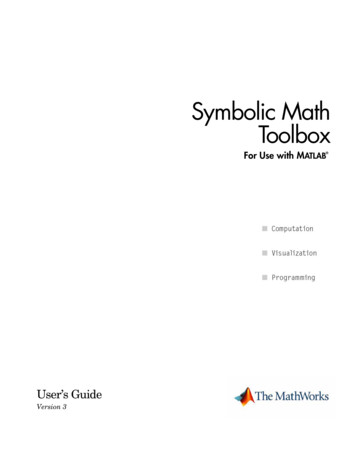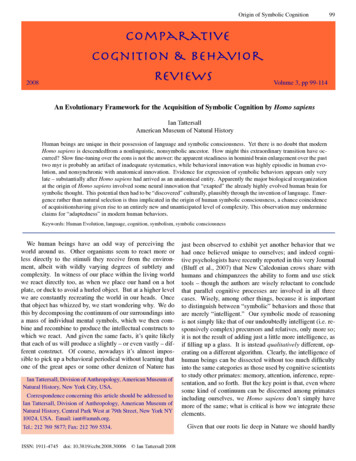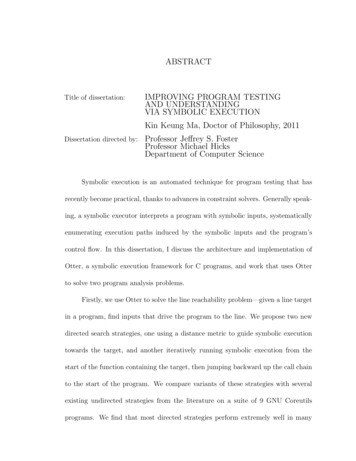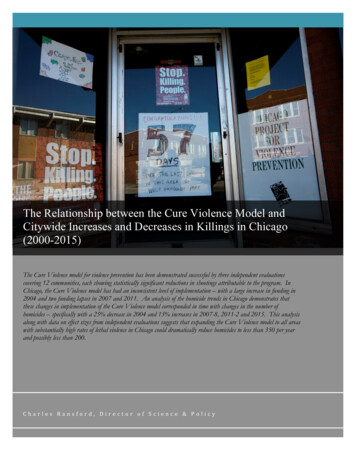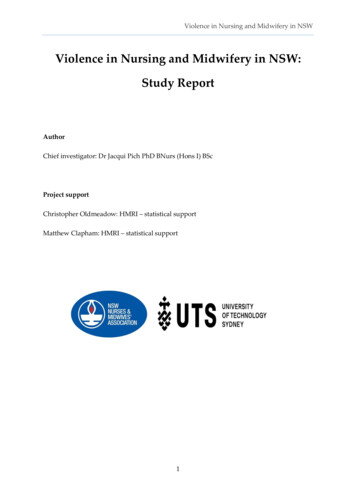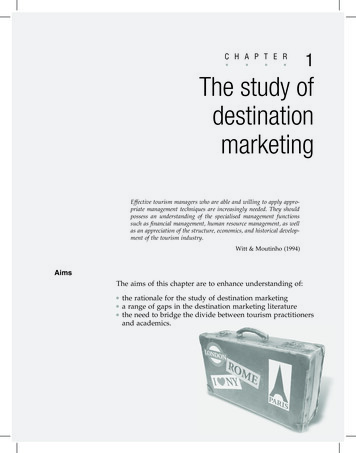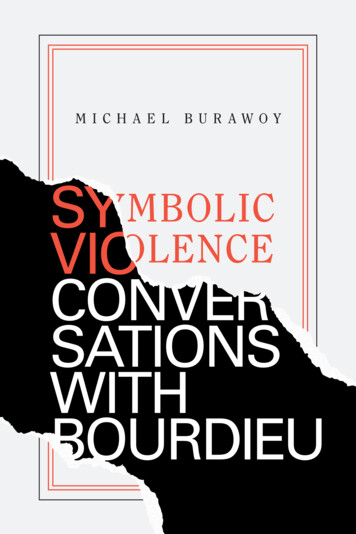
Transcription
M IC H A E LB U R ITHBOURDIEUConversationswithBourdieu
SYMBOLIC VIO LENCE
SYMBOLICVIO LENCECONVERSATIONSWITHBOURDIEUMichael BurawoyDUKE UNIVERSITY PRESSDURHAM AND LONDON2019
2019 Duke University PressAll rights reservedPrinted in the United States of Amer i ca on acid- free paper Designed by Drew SiskTypeset in Garamond Premier Pro by Westchester Publishing Ser vicesLibrary of Congress Cataloging- in- Publication DataNames: Burawoy, Michael, author.Title: Symbolic vio lence : conversations with Bourdieu / Michael Burawoy.Description: Durham : Duke University Press, 2019. Includesbibliographical references and index.Identifiers: lccn 2019006364 (print)lccn 2019009132 (ebook)isbn 9781478007173 (ebook)isbn 9781478005803 (hardcover : alk. paper)isbn 9781478006473 (pbk. : alk. paper)Subjects: lcsh: Bourdieu, Pierre, 1930–2002— Criticism andinterpretation. Sociology— France— History—20th century. Sociology— Philosophy.Classification: lcc hm479.b68 (ebook) lcc hm479.b68 b873 2019(print) ddc 301.01— dc23lc rec ord available at https:// lccn . loc . gov / 2019006364Cover art: Design and illustration by Drew Sisk
For Eriki
very power to exert symbolic vio lence, i.e. every powerEwhich manages to impose meanings and to impose themas legitimate by concealing the power relations which arethe basis of its force, adds its own specifically symbolicforce to those power relations.— P IERRE BOURDIEU AND JEAN- C LAUDE PASSERON,REPRODUCTION IN EDUCATION, SOCIETY AND CULTUREFor symbolic power is that invisible power which can beexercised only with the complicity of those who do notwant to know that they are subject to it or even that theythemselves exercise it.— PIERRE BOURDIEU, “ON SYMBOLIC POWER”
CONTENTSACKNOWL EDGMENTS7The So cio log i cal Imagination:Mills Meets Bourdieuix133PROLOGUEEncountering Bourdieu8The Twofold Truth of Labor:Burawoy Meets Bourdieu11481Sociology Is a Combat Sport:From Parsons to Bourdieu189The Weight of the World:Bourdieu Meets Bourdieu1722The Poverty of Philosophy:Marx Meets Bourdieu33CONCLUSIONThe Limits of SymbolicVio lence3191Cultural Domination:Gramsci Meets Bourdieu59NOTES2014Colonialism and Revolution:Fanon Meets BourdieuREFERENCES209765Pedagogy of the Oppressed:Freire Meets Bourdieu946The Antinomies of Feminism:Beauvoir Meets Bourdieu110INDEX217
ACKNOWL EDGMENTSFor many years I was a Bourdieu skeptic. Under pressure from Berkeleygradu ate students to take Bourdieu seriously, I enrolled in Loïc Wacquant’sBourdieu Boot Camp course in the spring of 2005. It opened my eyes tothe ever- expanding pa norama of Bourdieu’s oeuvre. It was in the memos forthat course that I first began imaginary conversations between Bourdieuand Marxism. It took me another four years to develop my own seminaron Bourdieu. Teaching is the greatest teacher of all. I owe an incalculabledebt to the students who have passed through t hose seminars but also to themany audiences who have listened to and commented on the enactment ofone or more of the conversations.Let me mention just a few who have enhanced these conversationswith conversations of their own—in Berkeley with Gabe Hetland, ZachLevenson, Mike Levien, Mara Loveman, Fareen Parvez, Gretchen Purser,Raka Ray, Adam Reich, Ofer Sharone, Mary Shi, Shelly Steward, CihanTuğal, and Loïc Wacquant; in Madison with Gay Seidman and Matt Nichter; in South Africa with Kate Alexander, Shireen Ally, Andries Bezuidenhout, Jackie Cock, Bridget Kenny, Oupa Lehoulere, Prishani Naidoo, SonjaNarunsky- Laden, Irma du Plessis, Vish Satgar, Jeremy Seekings, Ari Sitas,Tina Uys, Ahmed Veriava, Michelle Williams, Eric Worby, and, of course,Luli Callinicos and Eddie Webster; in France with Quentin Ravelli, UgoPalheta, Anton Perdoncin, Aurore Koechlin, and Sebastian Carbonell. Inaddition, I was very fortunate to have two encouraging but anonymous reviewers for Duke University Press.One friend and colleague, in particular— Jeff Sallaz— has been asource of continual support. When he was a gradu ate student at Berkeleyhe put up with my skepticism t oward Bourdieu, and then he was generousenough to help me through my conversion. When I first went public with myconversations at the University of Wisconsin– Madison in 2008, he listenedto the recordings in Arizona and sent me invaluable comments. When RuyBraga heard of my Madison conversations he thought they would be impor tant in Brazil for bridging the divide between Marxists and Bourdieusians. So
he or ga nized their translation and publication in Portuguese under the titleO marxismo encontra Bourdieu (Marxism meets Bourdieu).At the same time, Karl von Holdt, then head of the long- standingSociety, Work and Politics Institute (swop) at the University of the Witwatersrand in Johannesburg, invited me to give lectures in 2010. He bravelyaccepted my proposal to extend the six Madison conversations to eight.I faced a stimulating and engaged audience, as there always is at Wits, but Ihad a prob lem convincing them of Bourdieu’s importance. Karl saved theday, stepping in at the end of e very lecture to show the relevance of Bourdieu’s ideas for South Africa. His conversations about my conversations were duly published by Wits University Press in 2012 as Conversations withBourdieu: The Johannesburg Moment. Since then t here has been a Frenchversion in preparation by a group of young French sociologists.The biggest challenge of all was to produce a US version— one suitedto the US world of sociology. When Gisela Fosado of Duke University Pressinvited me to do just that, I set about revising the lectures once again andincluded two further conversations: one of Bourdieu with himself based onthe book La misère du monde (The Weight of the World), and a prologuetracing my successive encounters with Bourdieu— from skepticism to conversion to engagement. Fi nally, I wrote a new conclusion that arose froman ongoing dialogue with my colleague Dylan Riley, in which I redeemedBourdieu against Dylan’s Marxist critique.This all took much longer than expected, but now it is finished.Each conversation can be read by itself, but there is a cumulative theme thatinterrogates the underappreciated concept that lies at the heart of Bourdieu’swritings— symbolic vio lence.My lifelong friend and fellow Marxist Erik Wright had difficultyfathoming my Bourdieusian odyssey. While recognizing the enormous influence of Bourdieu’s work, he had l ittle patience for its arbitrary claims, itsinconsistencies, and its obscurantist style. His skepticism notwithstanding,it was Erik who invited me to give those experimental Madison lectures in2008. He helped me through them, commenting on them and orchestratinga lively conversation with the audience. He had a unique capacity to draw outwhat was salvageable, to separate the wheat from the chaff. For more thanforty years I was blessed by his generosity— emotional, intellectual, social,and culinary—as we each took intersecting paths between sociology andMarxism. He left us while I was putting the finishing touches to this book. Imiss him badly, as w ill so many o thers. He was an extraordinary h uman being.I dedicate this book to him and to the many adventures we had together.xAcknowl edgments
PROLOGUEENCOUNTERINGBOURDIEUMy path to Bourdieu has been long and arduous, strewn with skepticismand irritation. His sentences are long, his paragraphs riddles, his essays perplexing, his knowledge intimidating, his books exhausting, and his oeuvresprawling. When I thought I understood, I wondered what was novel. Struggling with his texts, I experienced the full force of symbolic vio lence. PierreBourdieu is not only the g reat analyst of symbolic vio lence, but he is also the great perpetrator of symbolic vio lence, cowing us into believing that some great truth is hidden in his work. For many years I was anti- Bourdieu.Taken individually his works are incomplete, but as the pieces cametogether I began to see the vision that arose from his theory of symbolicvio lence— a breathtaking pa norama stretched before me. Only by puttingsymbolic vio lence and its ramifications into conversation with Marxists, those enemies from whom he borrowed so much, could I begin to grasp andthen grapple with the ambition of his theoretical mosaic. The conversationsbegan as a mischievous game, but l ittle by l ittle the pace quickened, turninginto a trot and then into a headlong gallop as I became absorbed in my owngame, obsessed with Bourdieusian theory. The Bourdieusian lens rose evermore power ful, ever more paradoxical, posing a new challenge to Marxismand giving a new meaning to sociology.In the United States, as in other countries, sociologists grew increasingly receptive to Bourdieu over time, to the point that he is now one of thediscipline’s most- cited figures (Sallaz and Zavisca 2007). Critical sociologistsof education such as Annette Lareau (1989) w ere among the first adopters,extending Bourdieu’s early research on “schools as reproduction machines.”As more of Bourdieu’s books became available in En glish, scholars began
discussing and applying his famous troika of interrelated concepts: habitus,capital, and field. The reproduction of class through education continued tobe an arena for the fruitful application of t hese concepts (Lareau 2003; Kahn2011). Cultural sociologists, in works such as Michèle Lamont’s Money, Morals, and Manners (1994), considered how cultural capital creates symbolicbound aries in national contexts. Ethnographers began to use the concept ofhabitus to consider the interplay among structure, situation, and character(Wacquant 2004; Desmond 2007; Sallaz 2009). More recently, po liti cal andeconomic sociologists have adopted the concept of field to map and understand institutional space (Fligstein 2002; Eyal, Szelényi, and Townsley 1998;Medvetz 2012). As Bourdieu- inspired research in the US has developed, researchers increasingly work with multiple dimensions of Bourdieu’s theoretical troika.However, American sociologists rarely elaborate t hese conceptsinto a full- fledged account of symbolic vio lence— a form of dominationthat works through concealing itself from its agents, or, in Bourdieusianlanguage, a form of domination that works through misrecognition. Thecentral thesis of this book is that behind Bourdieu’s ideas of habitus, capital, and field lies the deeper notion of symbolic vio lence, itself connectedto reflexivity and public engagement. My goal is to unravel this under lyingstructure of Bourdieu’s theory by bringing his dif fer ent works into dialoguewith others, especially Marxists, who have also strug g led to understandpo liti cal and cultural domination.In putting Bourdieu into dialogue with the Marxist tradition, I amfollowing what he demands but rarely undertook, that is, to locate himself inrelation to his opponents, to those he repressed or dismissed. He advancedthe tools of reflexivity, adept at reducing others to their social positionor their place within fields, but he con ve niently left himself out of the account. This prologue is my attempt to give some sense of how, as a Marxist,I strug gled with Bourdieu and how these imagined conversations emergedfrom successive encounters with his work, positioning him in relation to anintellectual- political tradition he repudiated. There are three phases to my encounter. The first was skepticism,when I found Bourdieu’s work pretentious and unoriginal. The second wasconversion, when I discovered the depth and scope of his corpus to be seductive and a worthy challenge to Marxism. In the third phase, engagement— the chapters of this book— I bring Bourdieu into conversation with theenemies he thought he had slayed: in par tic u lar, Marx, Gramsci, Fanon,Freire, and Beauvoir. In putting him into conversation with C. Wright2Prologue
Mills, I show how the two converge, albeit from dif fer ent national and historical worlds. I then dare to generate my own conversation with Bourdieu,based on my own ethnography, engaging his idea of the twofold truth of labor. This then leads me to put Bourdieu into conversation with himself,surfacing a fundamental contradiction that threads through his work, between the logic of theory and the logic of practice. In the conclusion I offer aprovisional assessment of Bourdieu’s oeuvre. But first, here in this prologue,I follow Bourdieu’s prescription to reveal my modus operandi behind theopus operatum— the finished product that is the nine conversations.SKEPTICISMMy first encounter with Pierre Bourdieu’s work occurred when finishing mydissertation at the University of Chicago. It was 1976. My teacher, AdamPrzeworski, gave me an obscure article to read: “Marriage Strategies as Strategies of Social Reproduction” (Bourdieu [1972] 1976), since reproduced inThe Bachelors’ Ball ([2002] 2008a). H ere Bourdieu likens the kinship system in his home in the rural Béarn to a card game in which players are dealta par tic u lar hand (a combination of daughters and sons of dif fer ent ages) toconsolidate or expand their patrimony. Heads of families develop matrimonial strategies in light of the uncertain outcome of fertility strategies. Th ere were rules to be followed— some hard, some soft— but the game was, nonetheless, one of continual improvisation. For Przeworski, Bourdieu’s articleoffered a rare game- theoretic model of social reproduction, analogous to themodel he was developing for the strategies of po liti cal parties competing inelections under the limits defined by a changing class structure (Przeworskiand Sprague 1986).The reproduction of social structure through strategic action wasakin to my own repre sen ta tion of life on the shop floor in south Chicago(Burawoy 1979). I and my fellow machine operators strategized over the deployment of the social and material resources at our command within theconfines of the elaborate rules of “making out”— rules that were enforcedby all, often against our individual economic interests. Orchestrated by theparticipants, so I argued, the game of “making out” si mul ta neously securedand obscured surplus l abor, thereby mystifying the under lying class relations, a pro cess that Bourdieu would call misrecognition. While I d idn’tappreciate it at the time, t here was a strange convergence with Bourdieu’snotion of symbolic vio lence— a game that seduces participants into spontaneous consent while concealing the social relations that are the conditionsof its existence. Only many years l ater would I recognize similar argumentsEncountering Bourdieu3
at the heart of Bourdieu’s account of “double truth” in gift exchange, education, consumption, politics, and more.Before that moment of epiphany, though, my skepticism towardBourdieu’s work only deepened with each encounter. If the first meetingwith Bourdieu didn’t leave a deep impression, the second encounter leftme puzzled. This was the book that first made Bourdieu famous in theEnglish- speaking world— his collaboration with Jean- Claude Passeron, Reproduction in Education, Society and Culture ([1970] 1977). Put off by theabstruse language, I shrugged my shoulders and wondered what the fuss wasall about. The elaborate enumeration of propositions and sub- propositionsthat made up their “Foundations of a Theory of Symbolic Vio lence” led tothe same conclusion as Bowles and Gintis’s (1976) in their more accessibleSchooling in Cap i tal ist Amer i ca, which had also just appeared: educationreproduces class in equality. In their much discussed “correspondenceprinci ple,” Bowles and Gintis show how working- class children go toworking- class schools that lead to working- class jobs.Yet there was an impor tant difference. Bourdieu and Passeron argued that working- class kids went to “middle- class schools” and couldn’tcope because they didn’t possess the appropriate cultural capital. They retreated in shame, destined for the lower levels of the l abor market. Still, theoriginality escaped me. Basil Bern stein (1975) had made the same argumentfar more convincingly— the “restricted” linguistic codes of working- classkids disadvantaged them in schools that favored the “elaborated” linguisticcodes of children from the middle and upper classes. Paul Willis’s Learning to Labour (1977) would make the even more in ter est ing argument thatworking- class lads rebel against the school’s middle- class culture, leading them to embrace working- class culture and to enthusiastically seekworking- class jobs. By comparison Reproduction appeared formalistic in itsexposition, wooden in its abstraction, and mechanical in its understandingof human be hav ior. It was functionalism at its worst. Or so it appeared.But I had another axe to grind. As a follower of Louis Althusser(1969), Nicos Poulantzas (1973), Étienne Balibar (1977), Maurice Godelier(1972), and other Marxist structuralists, I found Reproduction to be an unacknowledged iteration of their arguments. Thus, Nicos Poulantzas’s analy sisof politics and the state and Étienne Balibar’s analy sis of law showed how formally neutral and “relatively autonomous” apparatuses, when placed alongside class in equality, reproduced that in equality and, moreover, did so in thename of universalism. The state and the law may not recognize class but inso doing all the more effectively reproduced class—an argument that Marx4Prologue
had made long ago in On the Jewish Question. In the same way, Bourdieu andPasseron showed how the arbitrary culture (presented as universal) of the“relatively autonomous” school reproduces arbitrary (class) domination. Yetthey wrote the book as a critique of Marxism even as they appropriated someof its reigning ideas. In short, Reproduction was annoyingly pretentious, withfew references to other works, while claiming an undeserved novelty.During the 1980s Bourdieu’s US audience widened as translationsof his work multiplied and secondary commentaries began to emerge.1 Hewas fast becoming a popu lar figure in Berkeley where I was teaching. So Ibegan by studying what was becoming a canonical text, especially amonganthropologists: Outline of a Theory of Practice ([1972] 1977)—an analy sisof the Kabyle, a major ethnic group in Algeria. Yet I found his theory ofpractice uncannily similar to the one developed by the Manchester school ofsocial anthropology. Particularly curious was his recapitulation of the workof my teacher in Zambia, Jaap van Velsen— a Dutchman and Oxford- trained lawyer, who became an anthropologist u nder the influence of Max Gluckman. Van Velsen’s monograph, The Politics of Kinship (1964), based on fieldwork in Malawi in the 1950s, argued that social action cannot be representedas the execution of prescribed norms but rather should be regarded as thepursuit of interests through the strategic manipulation of competing norms.True to his training, van Velsen regarded l egal contestation as a meta phorfor society. It was a profound break with classical anthropology, which reliedon in for mants who spun stories of symmetrical kinship patterns— idealizedversions of their community in which the anthropologist was treated to whatwas supposed to happen rather than to what actually happened.Van Velsen’s methodology was to document a succession of contentious cases that showed marriage patterns to be the result of feuding villa gers appealing to alternative norms. Dispensing with “in for mant anthropology,” he focused on the discrepancy between how p eople actually behavedand how they claimed to behave. Bourdieu advanced a parallel theory ofstrategic action in his study of the Kabyle but without intensive observational material—he was not trained as an anthropologist and, accordingto Fanny Colonna (2009), he did not even take field notes. For Bourdieu,this body of lit er a ture from across the Channel was not worthy of seriousengagement, even though his endnotes showed he was not unaware of theManchester school and, in par tic u lar, of the work of van Velsen. If t here wasanything novel to Bourdieu’s approach it was the concept of habitus, which,so it appeared to me, only added obfuscation to the Manchester school’ssituational analy sis.Encountering Bourdieu5
Outline of a Theory of Practice also suffered from an anthropological romanticism portraying the Kabyle as some isolated, self- reproducing“tribe” untouched by the colonial order, removed from the anticolonialstrug gle and disconnected from the wider economy. There is but one solitary reference to a mi grant returning from France who enters the analy sis because he violated the norms of gift exchange. In contrast, the second novelty of van Velsen’s (1960) work, and of the Manchester school more generally, was to determine how village life was s haped by wider social, po liti cal,and economic “fields” in which it was embedded. Thus, van Velsen (1967)traced anomalous matrimonial strategies among the Lakeside Tonga to theabsence of men who had migrated to the South African mines. This wasthe extended case method that explored micropro cesses in their relation toa wider context. Ironically, given Bourdieu’s l ater focus on “fields,” Outlineof a Theory of Practice showed no sign of any wider colonial field embedding the Kabyle. At the time, I was unaware of Bourdieu’s other work onAlgeria that put colonialism front and center, namely his study of urbanworking classes as well as the resettlement camps in the rural areas. Indeed,as others have pointed out, t here is a certain variance within his Algerianwriting (Goodman and Silverstein 2009), divided as it is between upholding the pristine “traditional” ethnic group and embracing a world- historicalmodernity brought to Algeria through colonialism. He would conceive ofsocial change, as Bronisław Malinowski had done before him, as a clash ofcultures. Once again, after reading Outline of a Theory of Practice I wondered,why all the fuss? It’s been said before and better.The next step on my Bourdieusian odyssey took me to Bourdieu’smagnum opus, Distinction, first published in En g lish in 1984. I took thismonster of a book with me to Hungary where I was then working in theLenin Steel Works. Every day, after coming off shift, I would write up myfield notes and then turn to Distinction. His “correspondence” analy sis didn’t correspond to my experiences of working- class life in state socialistHungary. But it was not the best of circumstances to appreciate such acomplex, detailed, exhaustive, and exhausting interrogation of the Frenchclass structure through the lens of cultural consumption. Still I understood enough—or so I thought—to won der whether Antonio Gramscihad not said it all before, but more succinctly and with more re spect forthe working class.At the time I was not aware of Bourdieu’s antipathy to Gramsci,but the idea that the cultural realm had a logic and coherence of its own,partially autonomous from the economic— a culture that emanated from6Prologue
the specific conditions of the dominant class but nonetheless claimed universality, seemed to be none other than a repackaging of Gramsci’s notionof hegemonic ideology. Given that Distinction was written in 1979, whenGramsci’s work was widely read in France, it was especially strange thathis name appeared but once in this voluminous book. Moreover, the classstructure that framed Bourdieu’s analy sis— dominant, new and old pettybourgeoisie, working class— seemed to fit Gramsci’s class perspective (withthe notable absence of the peasantry), as did the division of the dominantclass into economic and cultural fractions. It was only a partial replication ofGramsci since the chapter on politics had no conception of civil society orclass strug gle. I would later consider Gramsci and Bourdieu as antagonists,but at the time Distinction did not live up to the claim that it representedsome theoretical breakthrough in class analy sis; rather it was a subliminaladaptation of Gramscian ideas. Whether it was the analy sis of education, or rural Africa, or culturalconsumption in France, there seemed to be little that was original. How wasit, then, that I should descend from an adamant skepticism into the madding crowd of Bourdieusian devotees?CONVERSIONWith the erosion of interest in Marxism and feminism in the 1990s, Berkeley gradu ate students were developing a taste for Bourdieu— especially withwhat was then called the cultural turn. They could have their materialistcake and eat it with cultural sophistication. Bourdieu was fast becoming thetheorist of the moment, replacing Habermas and Foucault. Moreover, unlike these others, he was a sociologist with an enthusiasm for systematic em ere knocking on my door, demandingpirical research. Gradu ate students wI take him more seriously. At Berkeley, qualifying examinations in sociologyinclude a required field in social theory as well as two substantive fields.Students taking theory with me have to put the classics into conversationwith a con temporary theorist of their choice. While the list of acceptablecon temporary theorists was substantial, I drew the line at Bourdieu b ecause,so I claimed, he had no theory of history or social change— his was a theoryof social reproduction and not very original at that.2As Bourdieu’s light shone ever more brightly— especially after LoïcWacquant joined the department in 1994 and Bourdieu’s visit to the campus in 1995— the clamoring only became louder. So in 2003, I received adel e ga tion of four gradu ate students— Sarah Gilman, Fareen Parvez, Xiuying Cheng, and Gretchen Purser— requesting a reading course on Bourdieu.Encountering Bourdieu7
I agreed to meet with them every week and they could try to persuade methat my dismissive sentiments w ere a great mistake. I read their memos andlistened to their pre sen ta tions. Slowly but surely they introduced me to theastonishing breadth of Bourdieu’s research. While still skeptical I did beginto realize how little I knew about Bourdieu’s work and how limited was myunderstanding of his theory. The ice was melting but very slowly. Toward the end of the semester Gretchen Purser, exasperated by mycontinuing obduracy, came into my office, excitedly pointing to two pages toward the end of Pascalian Meditations on the twofold truth of labor. HereBourdieu appeared to have a dopted my theory of the l abor pro cess. I say“appeared to” because there was no reference to my book ManufacturingConsent— where I had argued that cap i tal ist work was or ga nized to si mul ta neously secure and obscure surplus l abor— although it had been e arlier discussed and excerpted in Bourdieu’s journal Actes de la Recherche en SciencesSociales. In Bourdieu’s rendition this became the “twofold truth of labor”—on the one side t here was the experience of the workers and on the otherside there was the social scientist’s truth, structurally inaccessible to thoseworkers. Bourdieu even invoked the idea of exploitation as being obscure toworkers. It was strange to find this Marxist blip in an ocean of anti- Marxismand even more surprising that Bourdieu was writing about labor, never oneof his central concerns (except, of course, as I was l ater to learn, in his Algerian writings). There was another intriguing convergence in our interpretation ofsocial structure as a game whose uncertainty secures participation whilesi mul ta neously obscuring the conditions and consequences of its reproduction. I d idn’t realize at the time that “securing and obscuring” was theessence of symbolic vio lence, the key to Bourdieu’s approach to all socialfields, to the wider society, and, indeed, to all socie ties throughout history!“Securing and obscuring”— though, of course, he never used those words— defined his methodology as well as his theory; it was the basis of the relationbetween the logic of practice and the logic of theory. Whereas I had confined the idea to the l abor pro cess, for Bourdieu symbolic vio lence seemedto be ubiquitous, to have no limits— a claim that I shall question in theseconversations.But I’m getting ahead of myself. Let’s return to the narrative of mydiscovery of Bourdieu with those four gradu ate students. Their memos hadpiqued my curiosity—it appeared that I was clearly more Bourdieusian thanI ever i magined. I clearly needed a remedial course in Bourdieu. I was inluck. In 2005, I asked my colleague Loïc Wacquant for permission to take8Prologue
his gradu ate seminar on Bourdieu. He agreed, but on the condition that Ibehave like any other gradu ate student, doing all the readings and submitting weekly memos. I happily complied. Loïc would deal the death blow toany remaining doubts I might have had about the importance of Bourdieu.Professor Wacquant is exciting and excitable— a brilliant expositorand merciless critic. He had no compunction about terrorizing the class, including me. Here was an uncompromising defender of all t hings Bourdieu,as if the master were flawless and the only thing left to do was to put himto work, applying him to the prob lems of the world. Wacquant had thrusthimself on Bourdieu, studied at his feet, and became a close collaborator,coauthor, official interpreter, and propagator- in- chief. In effect he becameBourdieu’s adopted son, and he oversaw many of the En glish translations ofBourdieu’s writings, acting as the guardian of Bourdieusian truth. I learned avast amount from Wacquant, who, as he used to say, knew Bourdieu’s worksbetter than Bourdieu. This book is a product of his course.Wacquant refers to his course on Bourdieu as a boot camp. Indeed,it was— involving a massive amount of reading and the writing of weeklymemos. An entirely new vista opened up before me— Bourdieu’s early workon Algeria, his enunciation of the craft of sociology, his successive accountsof the peasants of Béarn, his analy sis of politics, of the acad emy, o
Every power to exert symbolic violence, i.e. every power which manages to impose meanings and to impose them as legitimate by concealing the power relations which are the basis of its force, adds its own specifically symbolic force to those power relations. — PIERRE BOURDIEU AND JEAN-CLAUDE PASSERON, REPRODUCTION IN EDUCATION, SOCIETY AND CULTURE

